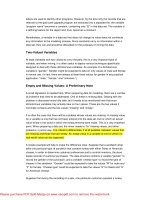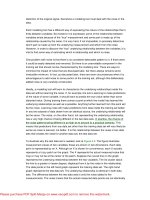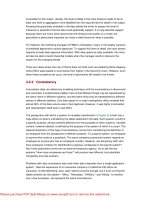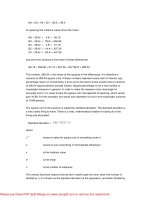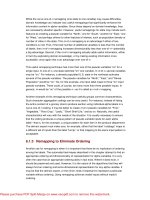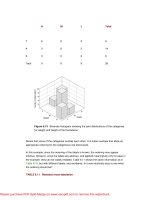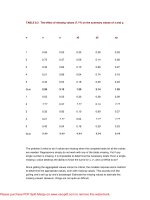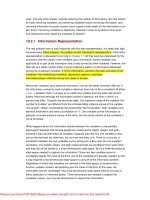Data Preparation for Data Mining- P5
Bạn đang xem bản rút gọn của tài liệu. Xem và tải ngay bản đầy đủ của tài liệu tại đây (352.01 KB, 30 trang )
is possible for the output. Usually, the level of detail in the input streams needs to be at
least one level of aggregation more detailed than the required level of detail in the output.
Knowing the granularity available in the data allows the miner to assess the level of
inference or prediction that the data could potentially support. It is only potential support
because there are many other factors that will influence the quality of a model, but
granularity is particularly important as it sets a lower bound on what is possible.
For instance, the marketing manager at FNBA is interested, in part, in the weekly variance
of predicted approvals to actual approvals. To support this level of detail, the input stream
requires at least daily approval information. With daily approval rates available, the miner
will also be able to build inferential models when the manager wants to discover the
reason for the changing trends.
There are cases where the rule of thumb does not hold, such as predicting Stock Keeping
Units (SKU) sales based on summaries from higher in the hierarchy chain. However, even
when these exceptions do occur, the level of granularity still needs to be known.
4.2.2 Consistency
Inconsistent data can defeat any modeling technique until the inconsistency is discovered
and corrected. A fundamental problem here is that different things may be represented by
the same name in different systems, and the same thing may be represented by different
names in different systems. One data assay for a major metropolitan utility revealed that
almost 90% of the data volume was in fact duplicate. However, it was highly inconsistent
and rationalization itself took a vast effort.
The perspective with which a system of variables (mentioned in Chapter 2) is built has a
huge effect on what is intended by the labels attached to the data. Each system is built for
a specific purpose, almost certainly different from the purposes of other systems. Variable
content, however labeled, is defined by the purpose of the system of which it is a part. The
clearest illustration of this type of inconsistency comes from considering the definition of
an employee from the perspective of different systems. To a payroll system, an employee
is anyone who receives a paycheck. The same company’s personnel system regards an
employee as anyone who has an employee number. However, are temporary staff, who
have employee numbers for identification purposes, employees to the payroll system?
Not if their paychecks come from an external temporary agency. So to ask the two
systems “How many employees are there?” will produce two different, but potentially
completely accurate answers.
Problems with data consistency also exist when data originates from a single application
system. Take the experience of an insurance company in California that offers car
insurance. A field identifying “auto_type” seems innocent enough, but it turns out that the
labels entered into the system—“Merc,” “Mercedes,” “M-Benz,” and “Mrcds,” to mention
only a few examples—all represent the same manufacturer.
Please purchase PDF Split-Merge on www.verypdf.com to remove this watermark.
4.2.3 Pollution
Data pollution can occur for a variety of reasons. One of the most common is when users
attempt to stretch a system beyond its original intended functionality. In the FNBA data,
for instance, the miner might find “B” in the “gender” field. The “B” doesn’t stand for “Boy,”
however, but for “Business.” Originally, the system was built to support personal cards,
but when corporately held credit cards were issued, there was no place to indicate that
the responsible party was a genderless entity.
Pollution can came from other sources. Sometimes fields contain unidentifiable garbage.
Perhaps during copying, the format was incorrectly specified and the content from one
field was accidentally transposed into another. One such case involved a file specified as
a comma-delimited file. Unfortunately, the addresses in the field “address” occasionally
contained commas, and the data was imported into offset fields that differed from record
to record. Since only a few of the addresses contained embedded commas, visual
inspection of parts of many thousands of records revealed no problem. However, it was
impossible to attain the totals expected. Tracking down the problem took considerable
time and effort.
Human resistance is another source of data pollution. While data fields are often
optimistically included to capture what could be very valuable information, they can be
blank, incomplete, or just plain inaccurate. One automobile manufacturer had a very
promising looking data set. All kinds of demographic information appeared to be captured
such as family size, hobbies, and many others. Although this was information of great
value to marketing, the dealer at the point of sale saw this data-gathering exercise as a
hindrance to the sales process. Usually the sales people discovered some combination of
entries that satisfied the system and allowed them to move ahead with the real business
at hand. This was fine for the sales process, but did the data that they captured represent
the customer base? Hardly.
4.2.4 Objects
Chapter 2 explained that the world can be seen as consisting of objects about which
measurements are taken. Those measurements form the data that is being characterized,
while the objects are a more or less subjective abstraction. The precise nature of the
object being measured needs to be understood. For instance, “consumer spending” and
“consumer buying patterns” seem to be very similar. But one may focus on the total dollar
spending by consumers, the other on product types that consumers seek. The information
captured may or may not be similar, but the miner needs to understand why the
information was captured in the first place and for what specific purpose. This perspective
may color the data, just as was described for employees above.
It is not necessary for the miner to build entity-relationship diagrams, or use one of the
Please purchase PDF Split-Merge on www.verypdf.com to remove this watermark.
other data modeling methodologies now available. Just understand the data, get
whatever insight is possible, and understand the purpose for collecting it.
4.2.5 Relationship
With multiple data input streams, defining the relationship between streams is important.
This relationship is easily specified as a common key that defines the correct association
between instances in the input streams, thus allowing them to be merged. Because of the
problems with possible inconsistency and pollution, merging the streams is not
necessarily as easy to do as it is to describe! Because keys may be missing, it is
important to check that the summaries for the assembled data set reflect the expected
summary statistics for each individual stream. This is really the only way to be sure that
the data is assembled as required.
Note that the data streams cannot be regarded as tables because of the potentially huge
differences in format, media, and so on. Nonetheless, anyone who knows SQL is familiar
with many of the issues in discovering the correct relationships. For instance, what should
be done when one stream has keys not found in the other stream? What about duplicate
keys in one stream without corresponding duplicates in another—which gets merged with
what? Most of the SQL “join”-type problems are present in establishing the relationship
between streams—along with a few additional ones thrown in for good measure.
4.2.6 Domain
Each variable consists of a particular domain, or range of permissible values. Summary
statistics and frequency counts will reveal any erroneous values outside of the domain.
However, some variables only have valid values in some conditional domain. Medical and
insurance data typically has many conditional domains in which the values in one field,
say, “diagnosis,” are conditioned by values in another field, say, “gender.” That is to say,
there are some diagnoses that are valid only for patients of one particular gender.
Business or procedural rules enforce other conditional domains. For example, fraud
investigations may not be conducted for claims of less than $1000. A variable indicating
that a fraud investigation was triggered should never be true for claims of less than $1000.
Perhaps the miner doesn’t know that such business rules exist. There are automated
tools that can examine data and extract business rules and exceptions by examining data.
A demonstration version of one such tool, WizRule, is included on the CD-ROM with this
book. Such a rule report can be very valuable in determining domain consistency.
Example 2 later in this chapter shows the use of this tool.
4.2.7 Defaults
Many data capturing programs include default values for some of the variables. Such
Please purchase PDF Split-Merge on www.verypdf.com to remove this watermark.
default values may or may not cause a problem for the miner, but it is necessary to be
aware of the values if possible. A default value may also be conditional, depending on the
values of other entries for the actual default entered. Such conditional defaults can create
seemingly significant patterns for the miner to discover when, in fact, they simply
represent a lack of data rather than a positive presence of data. The patterns may be
meaningful for predictive or inferential models, but if generated from the default rules
inside the data capture system, they will have to be carefully evaluated since such
patterns are often of limited value.
4.2.8 Integrity
Checking integrity evaluates the relationships permitted between the variables. For
instance, an employee may have several cars, but is unlikely to be permitted to have
multiple employee numbers or multiple spouses. Each field needs to be evaluated to
determine the bounds of its integrity and if they are breached.
Thinking of integrity in terms of an acceptable range of values leads to the consideration
of outliers, that is, values potentially out of bounds. But outliers need to be treated
carefully, particularly in insurance and financial data sets. Modeling insurance data, as an
example, frequently involves dealing with what look like outliers, but are in fact perfectly
valid values. In fact, the outlier might represent exactly what is most sought, representing
a massive claim far from the value of the rest. Fraud too frequently looks like outlying data
since the vast majority of transactions are not fraudulent. The relatively few fraudulent
transactions may seem like sparsely occurring outlying values.
4.2.9 Concurrency
When merging separate data streams, it may well be that the time of data capture is
different from stream to stream. While this is partly a data access issue and is discussed
in “Data Access Issues” above, it also needs to be considered and documented when
characterizing the data streams.
4.2.10 Duplicate or Redundant Variables
Redundant data can be easily merged from different streams or may be present in one
stream. Redundancy occurs when essentially identical information is entered in multiple
variables, such as “date_of_birth” and “age.” Another example is “price_per_unit,”
“number_purchased,” and “total_price.” If the information is not actually identical, the
worst damage is likely to be only that it takes a longer time to build the models. However,
most modeling techniques are affected more by the number of variables than by the
number of instances. Removing redundant variables, particularly if there are many of
them, will increase modeling speed.
If, by accident, two variables should happen to carry identical values, some modeling
Please purchase PDF Split-Merge on www.verypdf.com to remove this watermark.
techniques—specifically, regression-based methods—have extreme problems digesting
such data. If they are not suitably protected, they may cause the algorithm to “crash.” Such
colinearity can cause major problems for matrix-based methods (implemented by some
neural network algorithms, for instance) as well as regression-based methods. On the other
hand, if two variables are almost colinear, it is often useful to create a new variable that
expresses the difference between the nearly colinear variables.
4.3 Data Set Assembly
At this point, the miner should know a considerable amount about the input streams and
the data in them. Before the assay can continue, the data needs to be assembled into the
table format of rows and columns that will be used for mining. This may be a simple task
or a very considerable undertaking, depending on the content of the streams. One
particular type of transformation that the miner often uses, and that can cause many
challenges, is a reverse pivot.
4.3.1 Reverse Pivoting
Often, what needs to be modeled cannot be derived from the existing transaction data. If
the transactions were credit card purchases, for example, the purchasing behavior of the
cardholders may need to be modeled. The principal object that needs to be modeled,
then, is the cardholder. Each transaction is associated with a particular account number
unique to the cardholder. In order to describe the cardholder, all of the transactions for
each particular cardholder have to be associated and translated into derived fields (or
features) describing cardholder activity. The miner, perhaps advised by a domain expert,
has to determine the appropriate derived fields that will contribute to building useful
models.
Figure 4.3 shows an example of a reverse pivot. Suppose a bank wants to model
customer activity using transaction records. Any customer banking activity is associated
with an account number that is recorded in the transaction. In the figure, the individual
transaction records, represented by the table on the left, are aggregated into their
appropriate feature (Date, Account Number, etc.) in the constructed Customer Record.
The Customer Record contains only one entry per customer. All of the transactions that a
customer makes in a period are aggregated into that customer’s record. Transactions of
different types, such as loan activity, checking activity, and ATM activity are represented.
Each of the aggregations represents some selected level of detail. For instance, within
ATM activity in a customer record, the activity is recorded by dollar volume and number of
transactions within a period. This is represented by the expansion of one of the
aggregation areas in the customer record. The “Pn” represents a selected period, with “#”
the number of transactions and “$” the dollar volume for the period. Such reverse pivots
can aggregate activity into many hundreds of features.
Please purchase PDF Split-Merge on www.verypdf.com to remove this watermark.
Figure 4.3 Illustrating the effect of a reverse pivot operation.
One company had many point-of-sale (POS) transactions and wanted to discover the
main factors driving catalog orders. The POS transactions recorded date and time,
department, dollar amount, and tender type in addition to the account number. These
transactions were reverse pivoted to describe customer activity. But what were the
appropriate derived features? Did time of day matter? Weekends? Public holidays? If so,
how were they best described? In fact, many derived features proved important, such as
the time in days to or from particular public holidays (such as Christmas) or from local
paydays, the order in which departments were visited, the frequency of visits, the
frequency of visits to particular departments, and the total amount spent in particular
departments. Other features, such as tender type, returns to particular departments, and
total dollar returns, were insignificant.
4.3.2 Feature Extraction
Discussing reverse pivoting leads to the consideration of feature extraction. By choosing
to extract particular features, the miner determines how the data is presented to the
mining tool. Essentially, the miner must judge what features might be predictive. For this
reason, reverse pivoting cannot become a fully automated feature of data preparation.
Exactly which features from the multitudinous possibilities are likely to be of use is a
judgment call based on circumstance. Once the miner decides which features are
potentially useful, then it is possible to automate the process of aggregating their contents
from the transaction records.
Feature extraction is not limited to the reverse pivot. Features derived from other
combinations of variables may be used to replace the source variables and so reduce the
dimensionality of the data set. Even if not used to reduce dimensionality, derived features
can add information that speeds the modeling process and reduces susceptibility to noise.
Chapter 2 discussed the use of feature extraction as a way of helping expose the
Please purchase PDF Split-Merge on www.verypdf.com to remove this watermark.
information content in a data set.
Physical models frequently require feature extraction. The reason for this is that when
physical processes are measured, it is likely that very little changes from one stage to the
next. Imagine monitoring the weather measured at hourly intervals. Probably the
barometric pressure, wind speed, and direction change little in an hour. Interestingly,
when the changes are rapid, they signify changing weather patterns. The feature of
interest then is the amount of change in the measurements happening from hour to hour,
rather than the absolute level of the measurement alone.
4.3.3 Physical or Behavioral Data Sets
There is a marked difference in the character of a physical data set as opposed to a
behavioral data set. Physical data sets measure mainly physical characteristics about the
world: temperature, pressure, flow rate, rainfall, density, speed, hours run, and so on.
Physical systems generally tend to produce data that can be easily characterized
according to the range and distribution of measurements. While the interactions between
the variables may be complex or nonlinear, they tend to be fairly consistent. Behavioral
data, on the other hand, is very often inconsistent, frequently with missing or incomplete
values. Often a very large sample of behavioral data is needed to ensure a representative
sample.
Industrial automation typically produces physical data sets that measure physical
processes. But there are many examples of modeling physical data sets for business
reasons. Modeling a truck fleet to determine optimum maintenance periods and to predict
maintenance requirements also uses a physical data set. The stock market, on the other
hand, is a fine example of a behavioral data set. The market reflects the aggregate result
of millions of individual decisions, each made from individual motivations for each buyer
or seller. A response model for a marketing program or an inferential model for fraud
would both be built using behavioral data sets.
4.3.4 Explanatory Structure
Devising useful features to extract requires domain knowledge. Inventing features that
might be useful without some underlying idea of why such a feature, or set of features,
might be useful is seldom of value. More than that, whenever data is collected and used
for a mining project, the miner needs to have some underlying idea, rationale, or theory as
to why that particular data set can address the problem area. This idea, rationale, or
theory forms the explanatory structure for the data set. It explains how the variables are
expected to relate to each other, and how the data set as a whole relates to the problem.
It establishes a reason for why the selected data set is appropriate to use.
Such an explanatory structure should be checked against the data, or the data against the
explanation, as a form of “sanity check.” The question to ask is, Does the data work in the
Please purchase PDF Split-Merge on www.verypdf.com to remove this watermark.
way proposed? Or does this model make sense in the context of this data?
Checking that the explanatory structure actually holds as expected for the data available
is the final stage in the assay process. Many tools can be used for this purpose. Some of
the most useful are the wide array of powerful and flexible OLAP (On-Line Analytical
Processing) tools that are now available. These make it very easy to interactively examine
an assembled data set. While such tools do not build models, they have powerful data
manipulation and visualization features.
4.3.5 Data Enhancement or Enrichment
Although the assay ends with validating the explanatory structure, it may turn out that the
data set as assembled is not sufficient. FNBA, for instance, might decide that affinity
group membership information is not enough to make credit-offering decisions. They
could add credit histories to the original information. This additional information actually
forms another data stream and enriches the original data. Enrichment is the process of
adding external data to the data set.
Note that data enhancement is sometimes confused with enrichment. Enhancement
means embellishing or expanding the existing data set without adding external sources.
Feature extraction is one way of enhancing data. Another method is introducing bias for a
particular purpose. Adding bias introduces a perspective to a data set; that is, the
information in the data set is more readily perceived from a particular point of view or for a
particular purpose. A data set with a perspective may or may not retain its value for other
purposes. Bias, as used here, simply means that some effect has distorted the
measurements.
Consider how FNBA could enhance the data by adding a perspective to the data set. It is
likely that response to a random FNBA mailing would be about 3%, a typical response
rate for an unsolicited mailing. Building a response model with this level of response
would present a problem for some techniques such as a neural network. Looking at the
response data from the perspective of responders would involve increasing the
concentration from 3% to, say, 30%. This has to be done carefully to try to avoid
introducing any bias other than the desired effect. (Chapter 10 discusses this in more
detail.) Increasing the density of responders is an example of enhancing the data. No
external data is added, but the existing data is restructured to be more useful in a
particular situation.
Another form of data enhancement is data multiplication. When modeling events that
rarely occur, it may not be possible to increase the density of the rate of occurrence of the
event enough to build good models. For example, if modeling catastrophic failure of some
physical process, say, a nuclear power plant, or indicators predicting terrorist attacks on
commercial aircraft, there is very little data about such events. What data there is cannot
be concentrated enough to build a representative training data set. In this case it is
Please purchase PDF Split-Merge on www.verypdf.com to remove this watermark.
possible to multiply the few examples of the phenomena that are available by carefully
adding constructed noise to them. (See Chapter 10.)
Proposed enhancement or enrichment strategies are often noted in the assay, although
they do not form an integral part of it.
4.3.6 Sampling Bias
Undetected sampling bias can cause the best-laid plans, and the most carefully
constructed and tested model, to founder on the rocks of reality. The key word here is
“undetected.”
The goal of the U.S. census, for instance, is to produce an unbiased survey of the
population by requiring that everyone in the U.S. be counted. No guessing, no estimation,
no statistical sampling; just get out and count them. The main problem is that this is not
possible. For one thing, the census cannot identify people who have no fixed address:
they are hard to find and very easily slip through the census takers’ net. Whatever
characteristics these people would contribute to U.S. demographic figures are simply
missing. Suppose, simply for the sake of example, that each of these people has an
extremely low income. If they were included in the census, the “average” income for the
population would be lower than is actually captured.
Telephone opinion polls suffer from the same problem. They can only reach people who
have telephones for a start. When reached, only those willing to answer the pollster’s
questions actually do so. Are the opinions of people who own telephones different from
those who do not? Are the opinions of those willing to give an opinion over the telephone
different from those who are not? Who knows? If the answer to either question is “Yes,”
then the opinions reflected in the survey do not in fact represent the population as a
whole.
Is this bias important? It may be critical. If unknown bias exists, it is a more or less
unjustified assumption that the data reflects the real world, and particularly that it has any
bearing on the issue in question. Any model built on such assumptions reflects only the
distorted data, and when applied to an undistorted world, the results are not likely to be as
anticipated.
Sampling bias is in fact impossible to detect using only the data set itself as a reference.
There are automated methods of deriving measurements about the data set indicating the
possible presence of sampling bias, but such measurements are no more than indicators.
These methods are discussed in Chapter 11, which deals with the data survey. The assay
cannot use these automated techniques since the data survey requires a fully assembled
and prepared data set. This does not exist when the assay is being made.
At this stage, using the explanatory structure for the data, along with whatever domain
Please purchase PDF Split-Merge on www.verypdf.com to remove this watermark.
knowledge is available, the miner needs to discover and explicate any known bias or biases
that affected the collection of the data. Biasing the data set is sometimes desirable, even
necessary. It is critical to note intentional biases and to seek out other possible sources of
bias.
4.4 Example 1: CREDIT
The purpose of the data assay, then, is to check that the data is coherent, sufficient, can
be assembled into the needed format, and makes sense within a proposed framework.
What does this look like in practice?
For FNBA, much of the data comes in the form of credit histories purchased from credit
bureaus. During the solicitation campaign, FNBA contacts the targeted market by mail
and telephone. The prospective credit card user either responds to the invitation to take a
credit card or does not respond. One of the data input streams is (or includes) a flag
indicating if the targeted person responded or not. Therefore, the initial model for the
campaign is a predictive model that builds a profile of people who are most likely to
respond. This allows the marketing efforts to be focused on only that segment of the
population that is most likely to want the FNBA credit card with the offered terms and
conditions.
4.4.1 Looking at the Variables
As a result of the campaign, various data streams are assembled into a table format for
mining. (The file CREDIT that is used in this example is included on the accompanying
CD-ROM. Table 4.1 shows entries for 41 fields. In practice, there will usually be far more
data, in both number of fields and number of records, than are shown in this example.
There is plenty of data here for a sample assay.)
TABLE 4.1 Status report for the CREDIT file.
FIELD
MAX
MIN
DISTINCT
EMPTY
CONF
REQ
VAR
LIN
VAR-
TYPE
AGE
_INFERR
57.0
35.0
3
0
0.96
280
0.8
0.9
N
BCBAL
24251.0
0.0
3803
211
0.95
1192
251.5
0.8
N
BCLIMIT
46435.0
0.0
2347
151
0.95
843
424.5
0.9
N
Please purchase PDF Split-Merge on www.verypdf.com to remove this watermark.
BCOPEN
0.0
0.0
1
59
0.95
59
0.0
0.0
E
BEACON
_C
804.0
670.0
124
0
0.95
545
1.6
1.0
N
BUYER
1.0
0.0
2
0
0.95
353
0.1
0.7
N
CHILDREN
1.0
0.0
2
0
0.95
515
0.0
0.8
N
CRITERIA
1.0
1.0
1
0
0.95
60
0.0
0.0
N
DAS
_C
513.0
–202.0
604
0
0.95
437
10.3
1.0
N
DOB
_MONTH
12.0
0.0
14
8912
0.95
9697
0.3
0.6
N
DOB
_YEAR
70.0
0.0
42
285
0.95
879
0.5
1.0
N
EQBAL
67950.0
0.0
80
73
0.95
75
0.0
1.0
E
EQCURBAL
220000.0
0.0
179
66
0.95
67
0.0
0.0
E
EQHIGHBAL
237000.0
0.0
178
66
0.95
67
0.0
0.0
E
EQLIMIT
67950.0
0.0
45
73
0.95
75
0.0
1.0
E
EST
_INC_C
87500.0
43000.0
3
0
0.95
262
1514.0
0.9
N
HOME
_ED
160.0
0.0
8
0
0.95
853
3.5
0.7
N
HOME
_INC
150.0
0.0
91
0
0.95
1298
0.7
0.9
N
HOME
_VALUE
531.0
0.0
191
0
0.95
870
2.6
0.9
N
ICURBAL
126424.0
0.0
4322
1075
0.96
2263
397.4
0.9
N
IHIGHBAL
116545.0
0.0
4184
573
0.96
1192
951.3
0.9
N
Please purchase PDF Split-Merge on www.verypdf.com to remove this watermark.
LST
_R_OPEN
99.0
0.0
100
9
0.96
482
3.6
0.9
N
MARRIED
0.0
0.0
2
0
0.95
258
0.2
0.0
C
MOF
976.0
0.0
528
0
0.95
951
3.8
0.9
N
MTCURBAL
578000.0
0.0
3973
433
0.95
919
3801.7
1.0
N
MTHIGHBAL
579000.0
0.0
1742
365
0.95
779
4019.7
0.9
N
OWN
_HOME
0.0
0.0
1
0
0.95
60
0.0
0.0
N
PRCNT
_PROF
86.0
0.0
66
0
0.95
579
0.8
1.0
N
PRCNT
_WHIT
99.0
0.0
58
0
0.95
568
3.3
0.6
N
RBAL
78928.0
0.0
5066
18
0.97
795
600.3
0.8
N
RBALNO
14.0
0.0
14
0
0.95
642
0.1
0.9
N
RBAL
_LIMIT
9.0
0.0
10
0
0.95
618
0.1
0.8
N
RLIMIT
113800.0
0.0
6067
11
0.95
553
796.3
0.9
N
ROPEN
17.0
0.0
17
0
0.96
908
0.1
0.9
N
SEX
0.0
0.0
3
0
0.95
351
0.2
0.0
C
TBALNO
370260.0
0.0
7375
9
0.95
852
2383.7
0.7
N
TOPEN
17.0
0.0
18
0
0.95
617
0.1
0.9
N
UNSECBAL
23917.0
0.0
2275
781
0.95
1349
420.1
0.8
N
UNSECLIMIT
39395.0
0.0
1596
906
0.95
1571
387.9
0.9
N
YEARS_RES
15.0
0.0
17
21
0.95
431
0.4
0.9
N
Please purchase PDF Split-Merge on www.verypdf.com to remove this watermark.
